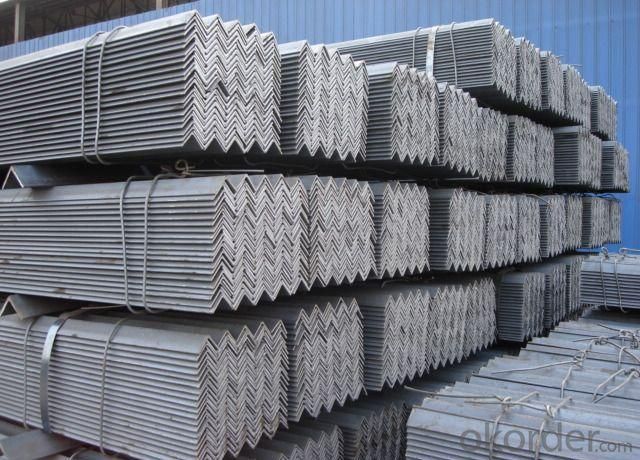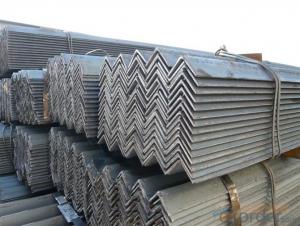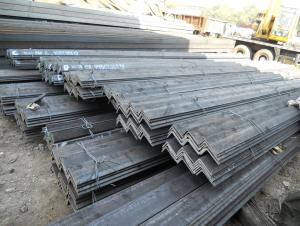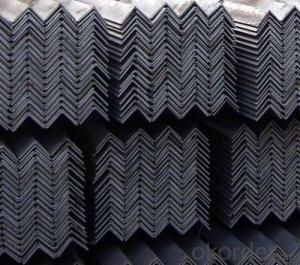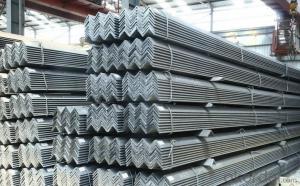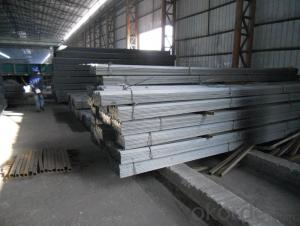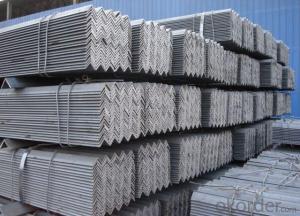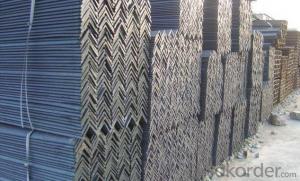Steel Equal Angle with Good Quality 140*140mm
- Loading Port:
- Tianjin
- Payment Terms:
- TT OR LC
- Min Order Qty:
- 100 m.t.
- Supply Capability:
- 15000 m.t./month
OKorder Service Pledge
OKorder Financial Service
You Might Also Like
Specification
Specifications of Steel Equal Angle with Good Quality 140*140mm
1. Invoicing on theoretical weight or actual weight as customer request
2. Length: 6m and 12m
3. Sizes:
| Size(mm) | Mass(kg/m) | Size(mm) | Mass(kg/m) |
| 140*140*10 | 21.488 | 140*140*14 | 29.49 |
| 140*140*12 | 25.522 |
Packaging & Delivery of Steel Equal Angle with Good Quality 140*140mm:
1. Packing: it is nude packed in bundles by steel wire rod
2. Bundle weight: not more than 3.5MT for bulk vessel; less than 3 MT for container load
3. Marks:
-Color marking: There will be color marking on both end of the bundle for the cargo delivered by bulk vessel. That makes it easily to distinguish at the destination port.
-Tag mark: there will be tag mark tied up on the bundles. The information usually including supplier logo and name, product name, made in China, shipping marks and other information request by the customer.
If loading by container the marking is not needed, but we will prepare it as customer request.
FAQ:
Q1: Why buy Materials & Equipment from OKorder.com?
A1: All products offered byOKorder.com are carefully selected from China's most reliable manufacturing enterprises. Through its ISO certifications, OKorder.com adheres to the highest standards and a commitment to supply chain safety and customer satisfaction.
Q2: How do we guarantee the quality of our products?
A2: We have established an advanced quality management system which conducts strict quality tests at every step, from raw materials to the final product. At the same time, we provide extensive follow-up service assurances as required.
Q3: How soon can we receive the product after purchase?
A3: Within three days of placing an order, we will begin production. The specific shipping date is dependent upon international and government factors, but is typically 1 to 2 months.
Q4: How many tons per bundle?
A4: Around 2-3tons
Q5: How to avoid the rust after deliver the goods to the loading port?
A5: We will keep the goods at the port covered with water-proof material
Production flow of Steel Equal Angle with Good Quality 140*140mm:
Material prepare (billet) —heat up—rough rolling—precision rolling—cooling—packing—storage and transportation
Images of Steel Equal Angle with Good Quality 140*140mm:
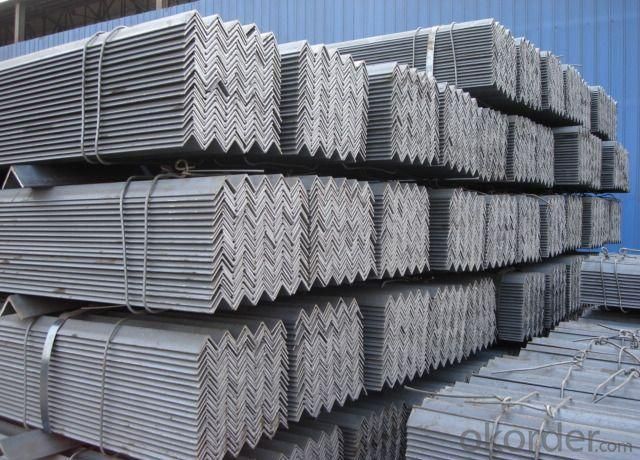
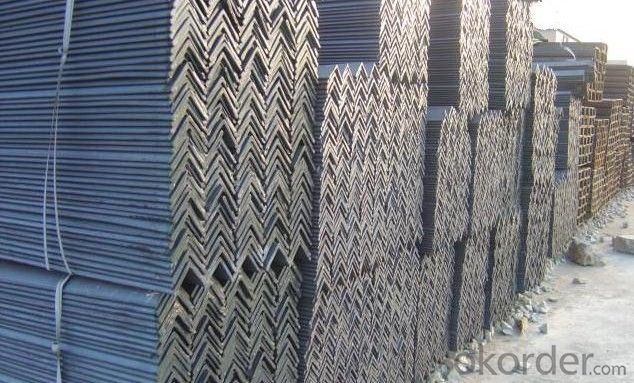
- Q: Are steel angles load-rated?
- Yes, steel angles are load-rated. The load rating of a steel angle depends on its dimensions, thickness, and material grade. The load rating is determined through engineering calculations and testing to ensure it can safely support specific loads and applications.
- Q: How do steel angles contribute to the seismic resilience of a structure?
- Steel angles are an essential component in enhancing the seismic resilience of a structure. These angled steel members are commonly used in construction to provide additional strength and stability, particularly in earthquake-prone areas. One way steel angles contribute to the seismic resilience of a structure is through their ability to resist lateral forces caused by seismic activities. During an earthquake, buildings are subjected to horizontal forces that can cause significant damage. Steel angles are strategically placed within the structure to help distribute and dissipate these forces, thus reducing the overall impact on the building. By acting as braces or stiffeners, steel angles enhance the structural integrity and prevent excessive deformation or collapse. Furthermore, steel angles are often used in conjunction with other seismic design strategies, such as moment frames or shear walls. These elements work together to create a robust and flexible structural system that can withstand the dynamic forces generated during an earthquake. Steel angles are typically integrated into these systems to provide additional reinforcement and increase the overall strength and rigidity of the structure. In addition to their role in resisting lateral forces, steel angles also contribute to the seismic resilience of a structure by improving its load-carrying capacity. By distributing loads more efficiently, steel angles help to reduce the stress on individual components, preventing localized failures and ensuring the overall stability of the structure. Moreover, steel angles are highly durable and possess excellent material properties, such as high tensile strength and toughness. This makes them well-suited for withstanding the dynamic loading and cyclic motions associated with earthquakes. Steel angles are also resistant to corrosion, which is crucial for maintaining the long-term structural integrity and overall performance of a building in seismic events. In conclusion, steel angles play a crucial role in enhancing the seismic resilience of a structure. By resisting lateral forces, improving load-carrying capacity, and providing durability, they contribute to the overall stability and integrity of the building. Incorporating steel angles into the design and construction process is essential for creating structures that can withstand seismic activities and ensure the safety of occupants.
- Q: What is the angle iron back machine?
- In the structure of angle steel tower, a large number of iron fittings are used. In order to make the connection tight, it is necessary to shovel or clean the angle iron of the iron connecting piece, and the NC angle steel back shovel is just for the purpose of cleaning the angle iron. For more detailed information, you can look at the super CNC website, they are professional manufacturers.
- Q: Are steel angles suitable for mezzanine floor construction?
- Yes, steel angles are suitable for mezzanine floor construction. Steel angles are commonly used in mezzanine floor construction due to their structural strength and durability. They provide excellent support and stability, making them an ideal choice for supporting the weight of the mezzanine floor and any loads placed on it. Steel angles can be easily bolted or welded together to create a strong framework for the mezzanine floor. Additionally, steel angles can be customized to fit specific design requirements, allowing for flexibility in mezzanine floor construction. Overall, steel angles are a reliable and cost-effective solution for mezzanine floor construction.
- Q: How do you specify steel angles in drawings?
- To properly describe steel angles in drawings, it is necessary to specify several crucial factors. First and foremost, the dimensions of the angle must be clearly indicated. This can be achieved by specifying the lengths of the legs or the dimensions of the equal sides. For instance, an angle measuring 3 inches by 3 inches with a thickness of 1/4 inch would be denoted as a 3" x 3" x 1/4" angle. The type of angle should also be specified, whether it is L-shaped or unequal. This information is vital in determining the most suitable steel angle for a particular application. Furthermore, it is essential to indicate the grade of the steel angle. Steel angles are available in various grades, each possessing different levels of strength and durability. Common grades include A36, A572, and A588, among others. The grade is typically specified to ensure that the angle meets the required structural or mechanical properties. The length of the steel angle is another significant parameter that must be stated in the drawing. Whether it is a fixed length or a specific range, this information facilitates accurate fabrication and installation. Lastly, any additional requirements or specifications, such as surface finish, tolerance, or specific treatments or coatings, should be clearly stated in the drawing. This ensures that the steel angle is manufactured and installed according to the desired specifications. By including these parameters in the drawings, engineers, fabricators, and contractors can easily identify and procure the necessary steel angles for construction or manufacturing purposes with precision.
- Q: How do you calculate the moment resistance of a steel angle?
- To calculate the moment resistance of a steel angle, you need to consider the geometry and material properties of the angle. The moment resistance refers to the ability of the angle to withstand bending forces. First, you need to determine the section modulus, which is a measure of the shape's resistance to bending. The section modulus can be calculated by taking the moment of inertia of the angle (I) and dividing it by the distance from the centroid of the shape to the furthest point (c). Next, you need to determine the yield strength of the steel angle. This is the point at which the material starts to deform permanently. The yield strength is typically provided by the manufacturer or can be obtained from material testing. Finally, the moment resistance can be calculated by multiplying the section modulus (Z) by the yield strength (σ). This gives you the maximum moment the steel angle can resist before it starts to deform permanently. Moment Resistance = Z * σ It is important to note that this calculation assumes the steel angle is subjected to pure bending. If there are additional factors such as axial or shear forces, additional calculations or considerations may be required. Additionally, it is always recommended to consult relevant design codes or engineering handbooks for more accurate and detailed calculations.
- Q: Can steel angles be used for reinforcement in concrete structures?
- Indeed, it is possible to utilize steel angles to reinforce concrete structures. These steel angles, referred to as L-shaped steel profiles, are frequently employed as reinforcing bars in the construction of concrete. Their purpose is to augment the strength and stability of the concrete structure, particularly in regions necessitating additional support. Typically, these steel angles are positioned within the concrete forms to ensure appropriate alignment and spacing, subsequently becoming embedded in the concrete during the pouring process. This reinforcement serves to prevent the occurrence of cracks and heightens the overall structural integrity of the concrete structure. Due to their versatility, steel angles are applicable in various concrete applications including beams, columns, walls, and slabs.
- Q: 6# specification for angle iron
- Angle: the angle called angle, the steel strip is perpendicular to each other on both sides into the corner. The angle iron has equal angles and unequal angles. The two sides of an equal angle steel are equal in width. The specifications are expressed in millimeters of edge width * edge width * edge thickness. Such as "/ 30 x 30 x 3", that is 30 mm width equal angle, edge thickness of 3 mm. Also available models that model is the number of centimeters wide, such as angle 3#. The model does not mean the size of the different edges and sizes of the same model. Therefore, the width, the edge and the thickness of the angle iron should be filled out in the contract and other documents, so as not to be indicated by the model alone. Standard Specification for hot-rolled equal angle iron is 2#-20#.
- Q: Can steel angles be used in equipment supports?
- Yes, steel angles can be used in equipment supports. Steel angles are often used in construction and structural applications due to their strength and versatility. They are commonly used as supports, braces, and reinforcements in various equipment and machinery. Steel angles provide stability and can withstand heavy loads, making them suitable for supporting equipment in industrial settings. Additionally, they can be easily fabricated and customized to fit specific requirements, making them a popular choice for equipment supports.
- Q: How do you prevent and address corrosion in steel angles?
- Corrosion prevention and addressing in steel angles can be achieved through several effective measures. Here are some steps you can take: 1. Proper surface preparation: Thoroughly clean the steel angles before applying any protective measures. Remove any dirt, grease, or other contaminants using a suitable solvent or detergent. 2. Protective coatings: Applying a high-quality coating is crucial to prevent corrosion. Options include paints, primers, and specialized corrosion-resistant coatings designed for steel. Ensure the coating is compatible with the environmental conditions the steel angles will be exposed to. 3. Galvanization: Galvanizing steel angles can provide excellent corrosion resistance. This involves applying a layer of zinc to the surface, creating a barrier between the steel and the corrosive elements in the environment. 4. Regular inspection and maintenance: Periodically inspect the steel angles for signs of corrosion, such as rust or pitting. Address any corrosion issues immediately to prevent further damage. This may involve removing the damaged coating, treating the corroded area, and reapplying a protective coating. 5. Cathodic protection: For critical applications or aggressive environments, consider implementing cathodic protection. This technique involves connecting sacrificial anodes or installing impressed current systems to protect the steel angles from corrosion by creating an electrochemical reaction. 6. Environmental control: Limiting exposure to moisture, humidity, and corrosive chemicals can significantly reduce the risk of corrosion. Proper ventilation, dehumidification, and avoiding direct contact with corrosive substances are essential preventive measures. 7. Routine cleaning: Regularly clean the steel angles to remove any accumulated dirt, debris, or corrosive substances, as they can accelerate corrosion. Use gentle cleaning methods and avoid abrasive materials that can damage the protective coating. Remember, preventing and addressing corrosion in steel angles requires a proactive approach. By implementing these measures, you can extend the lifespan of the steel angles and maintain their structural integrity.
Send your message to us
Steel Equal Angle with Good Quality 140*140mm
- Loading Port:
- Tianjin
- Payment Terms:
- TT OR LC
- Min Order Qty:
- 100 m.t.
- Supply Capability:
- 15000 m.t./month
OKorder Service Pledge
OKorder Financial Service
Similar products
Hot products
Hot Searches
Related keywords



